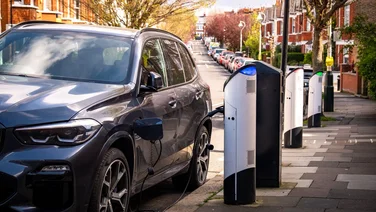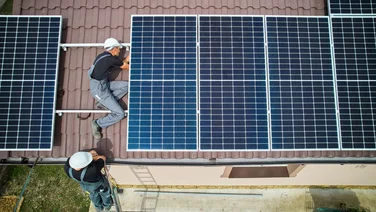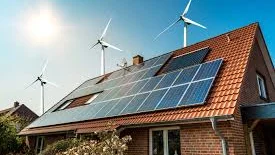- How many Brits would live beside a wind farm?
- How do different age groups feel about onshore wind farms?
- How does enthusiasm for onshore wind farms change across the UK?
- Why are some people reluctant to live next to an onshore wind farm?
- Are people justified in their dislike of onshore wind farms?
- Whats the future of onshore wind farms in the UK?
As part of our National Home Energy Survey we can reveal that one in two Brits would happily live next to an onshore wind farm.
Wind power is growing across the UK, and in the ongoing debate over soaring gas and electricity prices, you could easily say that wind power will only continue to increase in importance.
We surveyed 2,134 UK adults and found some interesting differences in how the generations answered, and how opinions on living next to wind farms changes across regions of the UK.

How many Brits would live beside a wind farm?

49% of the people we surveyed said they would live next to an onshore wind farm, which is hugely encouraging and a clear statement against the governments apparent dislike of them.
Prime Minister Rishi Sunak said he wanted to ban onshore wind farms when he came to power last year, but with one in two Brits happy with living next to them, its clear any ban would be unpopular.
We can understand why the last 12 months have shown that relying on fossil fuels to generate electricity is risky and expensive. Prices for gas and electricity have shot up throughout 2022, because of factors such as increased demand after the pandemic, and Russias war against Ukraine.
Wind turbines on the other hand, just need a strong gust to generate massive amounts of electricity. Look at how wind power performed in November 2022 wind farms produced a record 20 gigawatts (GW) of electricity, which represented over 70% of all electricity generated in the UK.
And in December 2022, the record was beaten again after wind turbines contributed 20.9 GW to the UKs grid.
But what of the people who didnt say yes to living near an onshore wind farm? Our survey revealed that just 20% of Brits said no to the idea, with the remaining 31% saying they werent sure.
The survey also revealed another interesting perspective 18% of the people who said they believed were experiencing a climate emergency, also said they wouldnt live near a wind farm.
A further 30% of the people saying yes to going through a climate emergency said they werent sure about living next to wind turbines. This is interesting because wind has been proven to be one of the most effective ways to reduce carbon emissions, which are directly contributing to human-made climate change.

How do different age groups feel about onshore wind farms?

Our survey highlighted something curious about attitudes towards living near onshore wind farms enthusiasm actually increases with age, until a slight drop off for the Silent Generation (born 1928 1945).
So thats 78% of Boomers (born 1946 1964) saying yes to living near wind turbines, which is fascinating because traditionally this is the generation most reluctant to adopt and be keen for low-carbon technologies.
Gen Z (born 1997 2013) responded with a measly 43% saying yes. This really surprised us because our survey showed they were the generation most concerned about climate change 91% to be exact.
Millennials (born 1981 1996) gave a better showing at 67%, but again it was lower than Boomers and the Silent Generation, who were 71% in favour of homes near wind farms.
The difference in responses for generations also ran contradictory to our questions about whether youd buy a home with solar panels, with 65% of Boomers saying yes compared to 74% for Gen Z and Millennials respectively.
How does enthusiasm for onshore wind farms change across the UK?

Wales is the part of the UK most enthusiastic about living next to an onshore wind farm, with 64% of people in Wales saying yes.
Looking at how people in Wales responded to other parts of our survey, were not too surprised. They were the most keen to buy or rent properties with solar panels with 75% saying they would, and they topped the list of people whove taken steps to improve the efficiency of their homes 62%.
Its a different picture if you look at London though, with just 42% of people living in the capital saying theyd be happy to live next to a wind farm. We should take this with a pinch of salt, as theres a chance respondents said no because itd mean leaving London.
Building wind farms in London is a tricky thing to do after all, not least due to lack of space but because there just wouldnt be enough wind with the buildings blocking most of it.
Why are some people reluctant to live next to an onshore wind farm?
The reasons why people are reluctant to live next to an onshore wind farm are varied. Some people wont purely for aesthetic reasons, and others still arent convinced of their effectiveness, even though 2022 was the best year for wind power in the UK ever.
One respondent in our survey said they wouldn’t want to live near wind turbines if they were a) visible, b) noisy, c) under construction, d) frequently had maintenance issues, e) created excess noise from cranes being used for repairs.
They did add that theyd be keener to rent a property if meant the rent was cheaper because of the turbines. Theres a sense here that people are concerned about wind turbines reducing a propertys value.
Another, who also said they would prefer not to live near a wind farm, said they might be swayed if there was an offer of free or heavily discounted electricity from the supplier.
This makes sense renewable energy should be cheaper because it doesnt rely on the fluctuating prices of fossil fuels. As weve seen over the last 12 months, rising energy bills are making the need for affordable, renewable energy greater than ever.
We also heard a lot of concern for wind turbines impact on nature, with several respondents saying they were worried about the number of birds killed by rotating turbine blades.
Are people justified in their dislike of onshore wind farms?
A lot of peoples dislike of onshore wind farms comes down to personal preference, and of the responses we got, none seemed to suggest they thought wind farms were bad in general.
The most common response was people not wanting wind farms to spoil their view, or not wanting to deal with the noise pollution, even though modern wind turbines emit just 40 decibels (dB) at a range of 350 metres. A standard refrigerator emits 50 dB, so youre unlikely to even notice the sound coming from wind turbines.
As for birds being killed by wind turbines, yes its an issue but the numbers pale into comparison when you look at the numbers of birds killed by domestic cats roughly 100,000 a year for wind turbines, versus an astonishing 27 million for our feline friends.
And unlike the unchanging instinct of Felis Catus, we can change our approach to wind turbines. Norway has begun experimenting with painting the blades on wind turbines black for example, and its already cut bird deaths by 72%.
Even despite bird deaths, the noise, and the perception that wind turbines are ugly, the reality is that if we dont shift to more renewables like wind power, the impact to the countryside will be far worse droughts caused by climate change will wither fields and flash floods brought by more extreme storms will wash away topsoil.
Explore the rest of our National Home Energy Survey 2023
Whats the future of onshore wind farms in the UK?
Onshore wind farms will expand in the UK, whether Rishi Sunak is keen on them or not, because theyre essential in moving the UK towards a renewable future.
Our survey proves their growing popularity too, and we believe its only a matter of time before more than half of the UK would want to live next to a wind farm. Its a case of stereotypes being disproved, particularly in terms of noise and visual appeal.
You can see how this years survey results have differed from last years National Home Energy Survey by clicking on the link.






